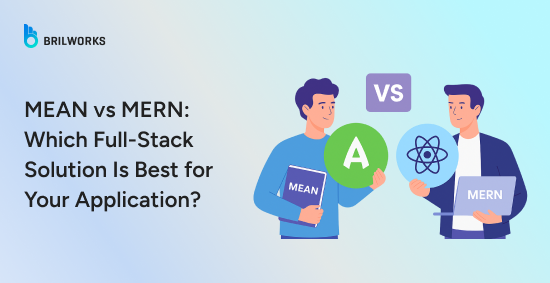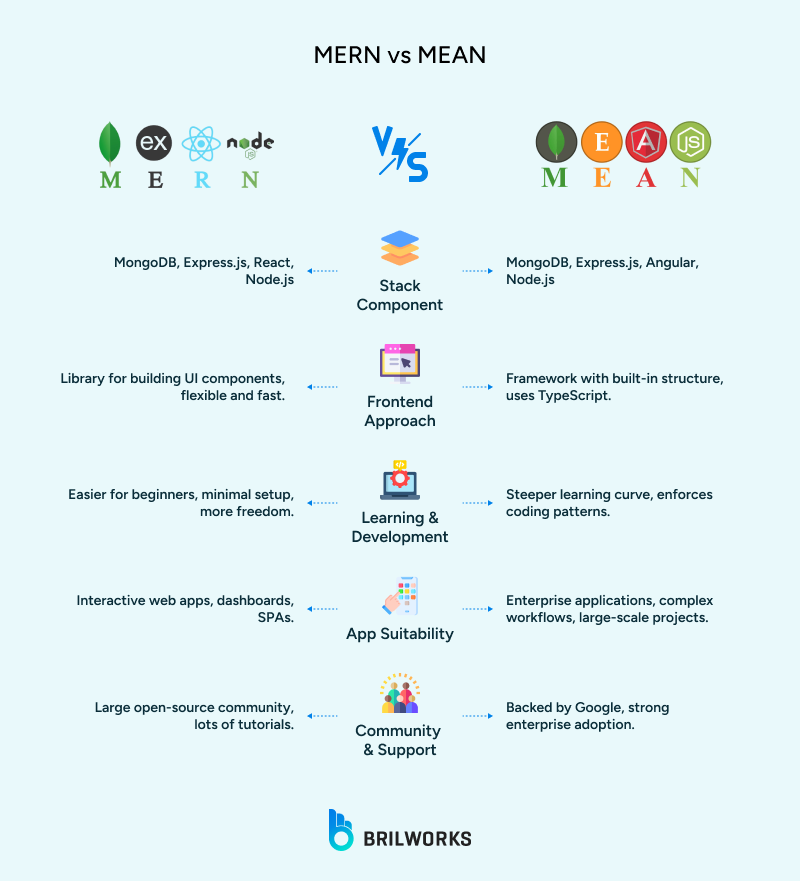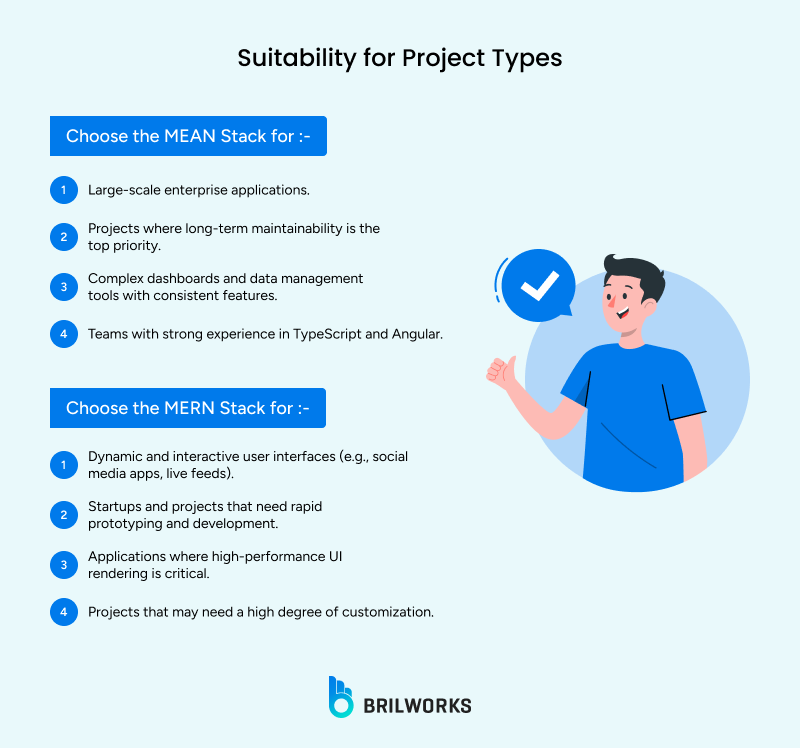COOPERATION MODEL
ARTIFICIAL INTELLIGENCE
PRODUCT ENGINEERING
DevOps & Cloud
LOW-CODE/NO-CODE DEVELOPMENT
INDUSTRY
FRONTEND DEVELOPMENT
CLOUD DEVELOPMENT
MOBILE APP DEVELOPMENT
LOW CODE/ NO CODE DEVELOPMENT
EMERGING TECHNOLOGIES








If you're leading IT, building a new web application can be a big responsibility. Your team might suggest using a JavaScript full-stack for faster development and a unified approach. While MEAN and MERN may seem similar at first, your choice can have a big impact on your project's success.
This decision goes beyond just technical details. It will influence your costs, performance, and how well your app can grow. This guide will help you compare MEAN and MERN so you can make a confident choice.
First, let's clarify the acronyms so you, as a business decision-maker, have a clear view.
Both stacks share three common parts:
M - MongoDB: A flexible, NoSQL database.
E - Express.js: A web application framework that runs on Node.js.
N - Node.js: A runtime environment that lets you run JavaScript on the server.
The crucial difference is the first letter.
MEAN uses A - Angular. Angular is a full-featured front-end framework.
MERN uses R - React. React is a powerful front-end library.
Knowing the difference between a framework like Angular and a library like React is important for your business. Think of Angular as a full set of building plans, while React gives you a flexible toolkit. The amount of structure or freedom you want will guide your app strategy.

Angular, developed by Google, is a complete solution. It is often called an "out-of-the-box" framework. It provides a strong set of rules and tools for building complex applications.
Structure and Maintainability: Angular enforces a specific code structure. This is an advantage for businesses with large teams or long-term projects. New developers can join and quickly understand the codebase, helping control maintenance costs.
All-In-One Solution: It includes everything you need for building a user interface. This includes data binding, dependency injection, and component-based routing. You do not need to choose extra libraries for core tasks.
Excellent for Enterprise Applications: Its rigid structure is perfect for large, complex applications. Think of internal dashboards, financial platforms, or enterprise-level CRMs where consistency is critical.
Steeper Learning Curve: Developers need to learn Angular's specific way of doing things. This can slow down the start of a project. It may also make it harder to find developers who are experts.
Less Flexibility: You must build your application the "Angular way." This can be limiting if your project has unique front-end needs.
React, maintained by Facebook (Meta), is a library focused on building user interfaces. It is famous for its flexibility and performance.
High Flexibility: React enables your team to assemble the best libraries for tasks like routing, state management, and more. This results in a custom toolkit tailored to your business needs. For more on this flexibility, see our focused analysis comparing React and Angular.
Superior Performance and UI Rendering: React uses a "virtual DOM." This makes updating the screen very fast. It leads to a highly responsive user experience. This is vital for apps with heavy user interaction.
Gentler Learning Curve and Rapid Development: Teams can get started quickly with React, which helps with faster prototyping and a shorter time to market. This is important for business leaders who want to stay agile.
Massive Community and Talent Pool: React is extremely popular. This means a larger pool of developers to hire from. It also means more solutions and resources available online.
Decision Overload: The flexibility can be a downside. Your team must research and choose the right combination of libraries. A wrong choice can cause problems later.
Potential for Inconsistency: Without strong architectural rules, different developers might write code in different ways. This requires strong team leadership to maintain code quality.
Let's compare them directly on the most important business factors.
|
Factor |
MEAN Stack |
MERN Stack |
Winner for... |
|
Architecture |
Full MVC Framework |
Flexible Library |
MEAN for rigid structure. MERN for freedom. |
|
Learning Curve |
Steeper |
Gentler |
MERN for faster project start-ups. |
|
Performance |
Good |
Excellent (Virtual DOM) |
MERN for highly dynamic user interfaces. |
|
Data Flow |
Two-way data binding |
One-way data flow |
MERN for more predictable and maintainable code. |
|
Scalability |
Good for large, structured apps |
Excellent for growing, evolving apps |
MEAN for large enterprises. MERN for scaling startups. |
|
Community & Job Market |
Strong and stable |
Very large and rapidly growing |
MERN has a slight edge in available talent. |
See Also: Nodejs vs Top backend Technologies
Looking past the technical details, the real difference between MEAN and MERN shows up in how developers use them and what communities support them. These trends show where the market is heading.
The data shows a clear trend in developer adoption. According to the 2025 Stack Overflow Developer Survey, when developers were asked about web frameworks and technologies they've done extensive development with in the past year:
React is used by 43.5% of professional developers.
Angular is used by 18% of professional developers.
This gap has been widening over recent years. The same survey shows React is the "most wanted" technology by developers who haven't used it but want to learn it. This indicates its growth is likely to continue.
Small businesses and startups often choose technology for speed and cost.
Many startups begin with MERN. Its gentle learning curve and fast UI development let small teams build a prototype quickly. They can test their idea in the market without a large upfront development cost. A small e-commerce site or a custom customer portal can be built and iterated rapidly with MERN.
Some small businesses in complex fields like finance or logistics choose MEAN from the start. They may have a clear, complex product vision that requires a strong foundation. The built-in structure of Angular helps them scale their codebase predictably as they grow, avoiding a major rewrite later.
“We, at Brilworks, started with the MERN stack because speed and hiring flexibility were our top priorities. React gave us the freedom to move fast and build exactly what we needed. But as the product matured and the codebase grew, that same flexibility became a challenge. We had to be intentional about enforcing consistency and structure across teams.
Looking back, Angular’s built-in guardrails might have simplified some decisions early on. Still, with strong senior developers and clear internal standards, React has allowed us to scale without losing control of our architecture.”
For someone new to programming, most experts and coding bootcamps now recommend starting with React. The reasons are practical:
Simpler Concepts: It's easier to grasp the core concepts of components and JSX before diving into Angular's comprehensive system of modules, dependency injection, and decorators.
Job Market Demand: As the usage stats show, there are significantly more job postings asking for React skills.
Transferable Knowledge: The fundamental concepts learned in React (components, state, props) are highly transferable and provide a solid foundation for understanding modern UI development, even if you learn Angular later.
Learning React first can lead to quicker employability. However, learning Angular is a very valuable and respected skill, especially for roles in large, established companies that value long-term code stability.
Based on these differences, here is which stack often works best:

Many industry leaders have chosen these stacks. Companies like PayPal, Netflix, and Airbnb use React (MERN). Google, Forbes, and IBM use Angular (MEAN). Both stacks are proven at scale.
The popularity of React is a significant factor. According to the Stack Overflow Developer Survey, React is the most wanted web technology, while Angular is often among the most dreaded.
What does this mean for you?
Easier Hiring: It is generally easier to find React developers. Many new developers learn React first.
Developer Preference: Developers often prefer working with React due to its flexibility and ease. This can improve team morale and retention.
Considering your team's skills is crucial. Forcing an Angular project on a team of React experts will lead to delays and frustration.
Considering your team's skills is crucial. Forcing an Angular project on a team of React experts will lead to delays and frustration.
Not sure which stack is right for your business? Our experts can review your project needs and suggest the best technology for performance, scalability, and cost. Reach out to Brilworks for a free consultation.
Not sure which stack is right for your business? Our experts can review your project needs and suggest the best technology for performance, scalability, and cost. Reach out to Brilworks for a free consultation.
There is no single "best" stack. There is only the best stack for your project.
You should lean towards the MEAN stack if your project is a large, complex enterprise application. You value long-term maintainability and a structured, all-in-one framework. Your team is comfortable with Angular's way of working.
You should lean towards the MERN stack if you need a dynamic, high-performance user interface. Your priority is rapid development and a faster time to market. You value flexibility and have a team that can make good choices about supporting libraries.
For many businesses today, especially those that need to move fast and keep users engaged, MERN is a strong choice because of its speed, flexibility, and large talent pool. But if you’re building large enterprise software, MEAN’s structure and all-in-one features can be a big advantage.
In the end, your decision should balance your app’s needs, your team’s strengths, and your long-term business goals.
Ready to start building your app with the right technology? Check out our custom web app development services to see how we can help bring your project to life.
Get In Touch
Contact us for your software development requirements
Get In Touch
Contact us for your software development requirements